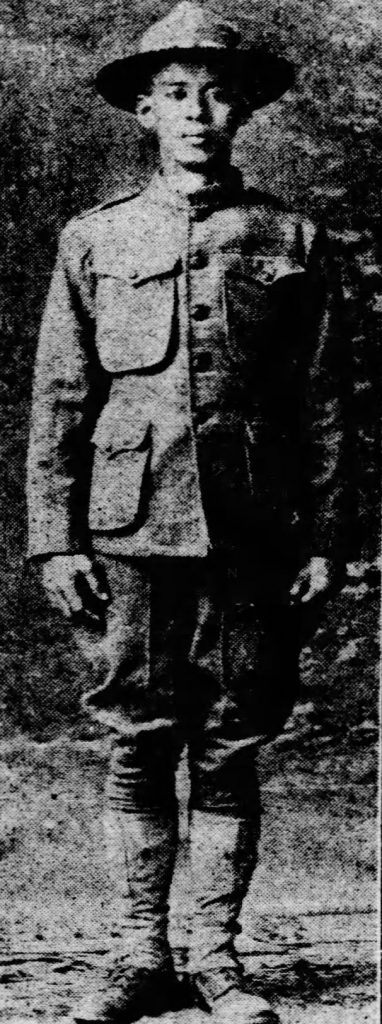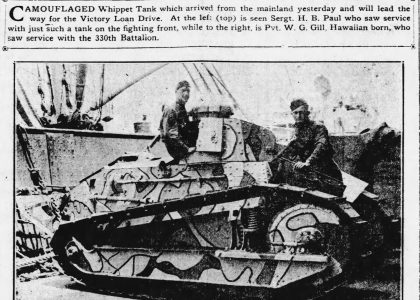 From Auto Stand to Army Enlistment
From Auto Stand to Army Enlistment
George Bung Tom was born in Honolulu to Chinese immigrant parents and grew up in a family that operated a small store at the corner of Nuʻuanu and Kukui Streets. He worked as a chauffeur at an auto stand near Bishop and King streets before joining the military. Friends and family described him as hard-working, well-liked, and independent.
When the call to service came in 1917, Tom did not wait for the draft. Instead, he volunteered to join the U.S. Army’s 3rd Engineers, later transferring to the 6th Engineers. He left with what newspapers called the “Aloha Contingent”—a group of young men from Hawaiʻi who departed for training and eventual deployment to the front lines in France (“George Tom,” 1919; “George Bung Tom Dies in France,” 1918). Before shipping out, local chauffeurs honored Tom and others leaving for the war with a farewell dinner at the Honolulu Chop Suey House on King Street. Auto stands temporarily closed so colleagues could pay tribute to their fellow drivers heading to France (“Chauffeurs Going to France to Be Dined,” 1918).
Service in France
Tom was sent to France in 1918, where he served in combat operations at Château-Thierry and the Battle of St. Mihiel. He fought alongside other Chinese-American soldiers from Hawaiʻi, including Joseph Tseu. The two were noted in local papers as having represented their community honorably in some of the most intense fighting of the war (“George Tom,” 1919).
In November 1918, Tom’s family received word, first interpreted as a report that he had been wounded. Later clarification confirmed the worst: he had died of illness in France. He was one of many American servicemen who succumbed to pneumonia or influenza during the final months of the war.
Tom’s death came as a shock to his family and community. His mother, who spoke little English, had not understood the initial cable. She told an interpreter that she “would be well at rest, just so she knew her boy had either been killed or wounded” (“George Bung Tom Dies in France,” 1918).
His young wife, whom he had married shortly before shipping out, was a schoolteacher. She reportedly learned of her husband’s death while at school in Waipahu and traveled to the Honolulu Advertiser office that evening in search of confirmation.
Return and Remembrance
The body of George Tom was returned to Honolulu in September 1921, along with that of fellow fallen soldier John R. Rowe. They had been buried temporarily in cemeteries in France and were later reinterred in their homeland. The American Legion arranged military honors upon their return (“Bodies of Local Men Who Fell in France,” 1921).
Tom’s name would be remembered not only in memorials but also through the formation of the Kau-Tom Post of the American Legion—a Chinese-American veterans’ post in Honolulu. This post was named partly in his honor and supported a wide network of Chinese-American veterans throughout the islands (“New Legion Post to Have No Trouble,” 1927).
“Pvt. George B. Tom of the 3rd Engineers is among those whom Hawaiʻi mourns, yet knows he placed Hawaiʻi’s name on the list of those who gave their sons to the cause of humanity.”
— Honolulu Star-Bulletin, May 10, 1919
Sources:
- Bodies of Local Men Who Fell in France Arrive on Transport. (1921, September 10). Honolulu Star-Bulletin, p. 1.
- Chauffeurs Going to France to Be Dined. (1918, July). Honolulu Star-Bulletin, p. 2.
- George Bung Tom Dies in France (Part I). (1918, November 13). Honolulu Star-Advertiser, p. 7.
- George Tom. (1919, May 10). Honolulu Star-Bulletin, p. 3.
- Honolulu Boy Is Wounded in France. (1918, November 12). Honolulu Star-Bulletin, p. 1.
- New Legion Post to Have No Trouble to Get Charter, Belief. (1927, November 22). Honolulu Star-Bulletin, p. 13.


